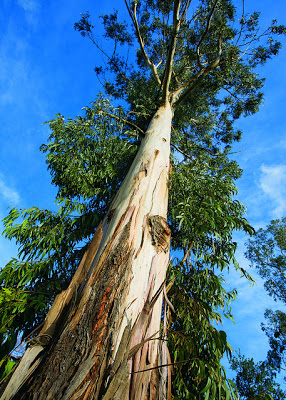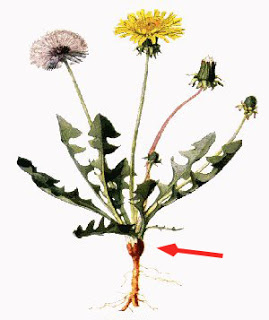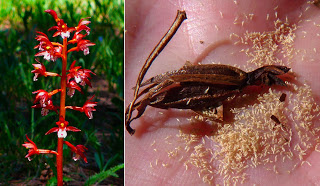Biology
Biology concepts ? angiosperm, utricle, fruit, flower, phytoremediation, monoecious, dioecious, stalk, stamen, pistil, acaulescent
Some of the most massive living organisms are flowering trees. The eucalyptus tree (Eucalyptus regnans) is the tallest/largest angiosperm in the world. Specimens can reach 380 ft (116 m), and can gain up to 200 ft (61 m) of this height in just their first 50 years. Eucalypts are also economically important, from wood to essential oils used in medicines. If this tree is the biggest flowering plant, what do we find on the other end of the scale? Could a small plant be just as important?
Watermeal is a floating plant, which is a good way to acquire water when you don?t have roots. I always assumed that the green dots that covered the surface of still waters were dropped leaves or small seeds, but it is very likely that I was looking at millions of individual plants.
You probably have an acaulescent plant growing in your yard right now, the dandelion. But wait, dandelions have stems with the flowers, right? But those aren?t stems, the stem (also called a crown) is underground. The flowers sit atop a stalk, part of the inflorescence (the total flower structure). Stalks connect parts of the plant to the stem, like petioles for instance. The petiole is the part of a leaf that connects the leaf blades to the stem; think celery stalks - those are petioles.
The world?s smallest flower also produces the world?s smallest fruit. The watermeal fruit is called a utricle, meaning it is thin walled and bladder-like, so it floats. The terminology for fruits is expansive. It would take a few posts to wade through it all ? maybe later. The globosa fruit is 0.4 mm long, half the size of the plant and 2x as big as the flower. Even though the fruit is the smallest on Earth, it is the world?s largest fruit relative to the size of the plant that produces it.
Could this speck of a watermeal plant impact humankind? You betcha. Soybeans are supposed to be the world?s superfood, being about 40% protein, but wolffia has the same amount of dietary protein as soybeans, with more of the essential amino acids that humans must gain from our food. And watermeal produces protein 50x faster than soybeans.
More important, watermeal may save us before we head to the stars. Humans have been wildly successful at poisoning the earth?s soil and water, so much so that this might be the reason we will have to visit other planets. W. globosa has a talent for pulling poisons out of water and sequestering them for disposal. Watermeal has long been known as a good accumulator of arsenic, W. globosa can tolerate such high levels of arsenic. Watermeal conjugates (chelates) arsenic with several proteins called phytochelatins, thereby thereby reducing the arsenic toxicity of freshwater. A 2012 study has identified just how watermeal survives the arsenic. It has an enzyme that converts the arsenic to a nontoxic form and also stimulates the production of the phytochelatins.
This ability to remove arsenic from water is matched by W. globosa?stalent for binding up cadmium as well. Cadmium is toxic to the human body, and is released from natural sources as well as from discarded or weathered paints and batteries. A 2013 study shows that watermeal is great at sequestering cadmium. It?s ability to remove cadmium from the environment is amazing since it is not affected by levels of arsenic in the plant ? it can detoxify water sources of potentially many poisons. Since it can grow so fast and takes such little room, this gives it a great potential for phytoremediation (phyto = plant, and remedium = restore balance).
Xie, W., Huang, Q., Li, G., Rensing, C., & Zhu, Y. (2013).CADMIUM ACCUMULATION IN THE ROOTLESS MACROPHYTE AND ITS POTENTIAL FOR PHYTOREMEDIATIONInternational Journal of Phytoremediation, 15 (4), 385-397 DOI: 10.1080/15226514.2012.702809
Zhang, X., Uroic, M., Xie, W., Zhu, Y., Chen, B., McGrath, S., Feldmann, J., & Zhao, F. (2012). Phytochelatins play a key role in arsenic accumulation and tolerance in the aquatic macrophyte Wolffia globosa Environmental Pollution, 165, 18-24 DOI: 10.1016/j.envpol.2012.02.009
- Plant Divisions
4 Plant Divisions: Bryophytes are the most common plant division and are made up mosses, liverworts and hornworts. They are found in almost every habitat, including deserts but are most adaptable to moist environments. This is thought to be the first...
- Phloem & Xylem
Are Phloem and Xylem Similar? What are the Differences? Similarities: Phloem and xylem are tissues in a plant that transport food and water. Both are vascular tissues and when they work together to effectively transport food, water and minerals they form...
- Angiosperm
Term: angiospermLiterally meaning: ?sperm vessel?Origin: Anc Greek??????/aggio (=vessel, receptacle) > ?????/aggos(=tube)?????? (=seed) > ??????/spearo (=disperse)Coined/HistoryAngiosperms appeared during Jurassic period (203-135 million...
- The Most: Related To Plants
1. Commonest grass Cynodon dactylon (doob), Gramineae 2. Deadliest plant Ricinus communis has seeds rich in poison, ?ricin? which is about 6000...
- Go Prune The Grass?
Biology concepts ? meristem, monocot, dicot, herbaceous, arborescent, xylem, phloem Knots can form in trees for different reasons. When you prune a limb back and a callus grows over it in a few years, this may form a loose knot. Even limbs that are still...
Biology
A Big Plant In A Little Package
Biology concepts ? angiosperm, utricle, fruit, flower, phytoremediation, monoecious, dioecious, stalk, stamen, pistil, acaulescent
 |
Eucalyptus regnans is the tallest flowering plant in the world. It grows in southeastern Australia and Tasmania. As a eucalypt, it is food for koala bears, but I can?t imagine a small koala climbing a monster like this for food. There are over 600 species of eucalyptus leaf that koalas can feed on, most of them being closer to the ground than these leaves. |
Question of the Day ? What are the world?s smallest flowering plant, fruit, and seed?
To be an angiosperm, a plant must produce a fruit of some kind and have enclosed seeds (angio = vessel, and sperm = seed, so seeds in a vessel). It will have a pistil and/or stamen, and if fertilized, the embryo becomes a seed and a fruit formed from the ovary (and perhaps other parts).
There is no size requirement to be an angiosperm, it just has to be big enough to carry the requisite anatomical features. Flowering plants run the gamut of sizes, from huge trees to small Australian violets (Viola hederacea) at only 1.5 in. (3.8 cm). But even this tiny violet, with its 0.25 in. (6 mm) flowers is huge compared to the smallest of the flowering plants.
Imagine a thimble filled with plants. How many plants? How about 5000! Not seeds mind you, but fully mature plants. This is easy for the watermeal plant (Wolffia globosa), the world?s smallest flowering plant. When you pick up a single plant (if you can), you can hardly see it on your finger. The entire plant is only 0.6-0.8 mm long, about the same size as a grain of salt, and weighs only 150 micrograms (0.00015 grams).
It takes a determined plant to fit itself into such a small volume. Decisions must be made about what is necessary and what can be lost. In evolutionary terms, this is called reduction. W. globosa is a greatly reduced plant. It has no roots, no leaves, no petals, and no stem to speak, although developmental studies show that it's mass is part stem, part leaf.
 |
I bet we have all seen a pond or wetland that looks like the one on the left. I had always assumed that the green covering was algae or leaves or pollen that had fallen from trees. Now I know that it might just as well be hundreds of a millions of individual plants. On the right is a picture that gives you some scale, every green speck there is an individual, mature, reproducing plant. |
W. globosa is also one of the fastest growing plants in the world. It can double its biomass in just 30 hours. We think of bamboo as a fast growing plant, and it is, but doubling time for a bamboo plant can is measured in days or weeks, not in hours.
The water hyacinth (Eichhornia crassipes) was supposedly the fastest growing angiosperm in the world, with a biomass doubling time of six days under the best growing conditions. I think this was probably before they started looking at watermeal in more depth. It could be easy to overlook.
The fast reproduction and growing time for W. globosa means that it can completely cover a pond in a matter of days. This reduces the amount of sunlight for underwater plants, and crowds out the photosynthetic phytoplankton. Dissolved oxygen will become depleted. This could lead to a fish kill that would decimate the entire pond. Watermeal is so small that it is easily transferred to other bodies of water on the feathers and feet of ducks, so it is invasive. ?Reduced? apparently doesn?t apply to survival capability.
Wolffia gets away with being leafless because it has chloroplasts in the cells of its body. I don?t really know what to call the body of watermeal. It isn?t a stem, since a stem connects different structures of a plant to one another. In the case of W. globosa, there is nothing to connect to anything else.
There are other plants that don?t show a stem above ground, but they have a connection for leaves to the root, and these are called acaulescent (a = without, and caulis = stem) plants. For example, many succulents have thick leaves that come straight out of the ground.
 |
The common dandelion (Taraxacum officinale) is an acaulescent plant. The stem is the unelongated nodule to which tall the leaves attach and is usually found underground. The flowers sit atop a hollow stalk which is not a stem, and the yellow blooms are not individuals, but actually hundreds of individual flowers. |
W. globosa does have a flower, but you wouldn?t recognize it. The flower is held in a small cavity on the top of the football shaped plant (see picture). The flower is also reduced, having only one pistil and one stamen. Pistil is the name for the complete female structure, including the stigma, the style, and the ovary. The stamen is the name given to the complete male structure, including the filament and the pollen-producing anther.
These are the only parts of a flower that are necessary; many flowers just have one or the other (male or female flowers). Plants that have both types of flowers on a single individual are called monoecious, while plants with just one type or the other are dioecious. So even though the flower of the watermeal has no petals and is only 0.2 mm in diameter, it is functionally more complete than flowers that are thousands of times its size.
The white bar in this picture is 0.25 mm long ? see how small Wolffia is! This isn?t even W. globosa, the smallest species, but one of its bigger cousins, W. australiana. The flower sits in the little pit on the top, and it has a two lobed anther (A1 and A2), as well as a pistil (Pi). The MF is the mother frond, and the DF is the clonal daughter bud. Remember that wolffia species float, so the ventral bulge (VB) keeps them right side up. Other labels (DL is where the anther splits to release pollen, and S is the stomata for gas exchange). |
W. globosa is an exception in that it is an angiosperm that most often reproduces through asexual means. Watermeal usually buds, much like yeast or coral polyps. The bud grows from the end of the mature watermeal and can be as large as the parent plant. This is why W. globosa is fast growing; by the time the bud separates, it is a mature plant.
In the rare cases that it is pollinated, just one seed is produced. You would think that it would be the world?s smallest seed, but it isn?t - not by a long shot. The W. globosa seed is 0.3 mm, between half and ¾ the size of the fruit, but some orchids have much smaller seeds.
The coral root orchid (Corallorhiza maculata) has seeds that measure just 0.085 mm each ? there are bacteria larger than that! There are many similarities between the coral root and W. globosa. Coral root doesn?t have leaves or roots to speak of, just like watermeal. It is parasitic and gathers its nutrition from the soil fungi. The main difference is that while wolffia produces only one seed, the orchid has thousands, easily dispersed by the wind, since it takes 375,000 of the to equal one ounce (28 g).
 |
The coral root orchids on the left is Corallorhiza maculata. It grows in North America. It has no leaves, and no conventional roots, just suckers that invade and parasitize the fungal mats that live just below ground. It gains all its nutrients this way, it does not make chlorophyll. On the right are the fruits of the coral root. While the capsule is large and has many seeds, each small white structure houses only one seed, the smallest seeds in the world. You can?t even see the seed itself, it is so small. |
Could this speck of a watermeal plant impact humankind? You betcha. Soybeans are supposed to be the world?s superfood, being about 40% protein, but wolffia has the same amount of dietary protein as soybeans, with more of the essential amino acids that humans must gain from our food. And watermeal produces protein 50x faster than soybeans.
W. globosa is already used a vegetable in southeast Asia, but with its high protein and carbohydrate concentrations, small size, easy growing conditions and rapid maturation reproduction, it may be much more. There are scientists who are proposing that watermeal form the basis of the astronaut on trips to Mars and beyond.
 |
Don?t think phytoremediation is important? This is a picture of itai-itai disease due to cadmium poisoning. Itai-itai translates as ?it hurts-it hurts.? The cadmium poisoning leads to osteomalacia, a softening of the bones, so that the body can?t support its own weight. Watermeal can take cadmium out of the environment. A big deal for a little plant. |
Xie, W., Huang, Q., Li, G., Rensing, C., & Zhu, Y. (2013).CADMIUM ACCUMULATION IN THE ROOTLESS MACROPHYTE AND ITS POTENTIAL FOR PHYTOREMEDIATIONInternational Journal of Phytoremediation, 15 (4), 385-397 DOI: 10.1080/15226514.2012.702809
Zhang, X., Uroic, M., Xie, W., Zhu, Y., Chen, B., McGrath, S., Feldmann, J., & Zhao, F. (2012). Phytochelatins play a key role in arsenic accumulation and tolerance in the aquatic macrophyte Wolffia globosa Environmental Pollution, 165, 18-24 DOI: 10.1016/j.envpol.2012.02.009
- Plant Divisions
4 Plant Divisions: Bryophytes are the most common plant division and are made up mosses, liverworts and hornworts. They are found in almost every habitat, including deserts but are most adaptable to moist environments. This is thought to be the first...
- Phloem & Xylem
Are Phloem and Xylem Similar? What are the Differences? Similarities: Phloem and xylem are tissues in a plant that transport food and water. Both are vascular tissues and when they work together to effectively transport food, water and minerals they form...
- Angiosperm
Term: angiospermLiterally meaning: ?sperm vessel?Origin: Anc Greek??????/aggio (=vessel, receptacle) > ?????/aggos(=tube)?????? (=seed) > ??????/spearo (=disperse)Coined/HistoryAngiosperms appeared during Jurassic period (203-135 million...
- The Most: Related To Plants
1. Commonest grass Cynodon dactylon (doob), Gramineae 2. Deadliest plant Ricinus communis has seeds rich in poison, ?ricin? which is about 6000...
- Go Prune The Grass?
Biology concepts ? meristem, monocot, dicot, herbaceous, arborescent, xylem, phloem Knots can form in trees for different reasons. When you prune a limb back and a callus grows over it in a few years, this may form a loose knot. Even limbs that are still...
